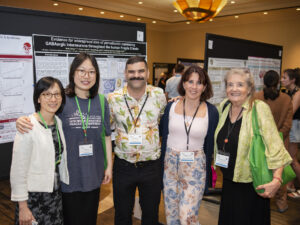Authors: Melissa Raspa, PhD, Don Bailey, PhD (Distinguished Fellow), Carla Bann, PhD (Statistician), and Ellen Bishop (Lead Programmer)
Family adaptation is the process by which parents and other family members adjust, accommodate, or transform their roles and responsibilities to better meet current demands. All families must change and adapt over time, but this is especially true for families who have a child with Fragile X syndrome (FXS). For these families, adaptation begins with the diagnosis and continues throughout their child’s life.[1] [2] [3] [4] [5] Adaptation is a complex process and involves changes on multiple levels. Ultimately, positive adaptation is needed to ensure good outcomes for both children and families.[6] [7]
Several unique characteristics of FXS suggest that it is an especially important condition in which to study family adaptation. FXS is passed on to children through carrier parents, and because children often aren’t diagnosed until 36 months of age, approximately 25 percent of families have more than one affected child.[8] FXS can affect extended family members and the diagnosis may have an impact on family cohesion and dynamics as well.[9] Individuals with the full mutation often have developmental delays, attention problems, hyperactivity, autism, and behavior problems, though there is wide variation in the FXS phenotype. Individuals who are premutation carriers of Fragile X, may experience cognitive or emotional challenges, although less severely. Carriers are also at risk for Fragile X-associated primary ovarian insufficiency (FXPOI) and Fragile X-associated tremor Ataxia Syndrome (FXTAS). Collectively, these challenges may make it harder for families to adapt to the needs of their child (or children) and often have negative effects of parents themselves.IMG_2517
The purpose of this study was to draw on data from a national survey to address gaps in the current knowledge of family adaptation to FXS. First, we wanted to describe the nature of both positive and negative family adaptation to FXS. Using more than 1,000 families who had a child with the full mutation or premutation of FXS, we sought to characterize and quantify multiple areas of adaptation, many of which have not been previously reported, including parenting knowledge of FXS, social support, respondent well-being, family social life, financial impact, family quality of life, and overall family impact. We also wanted to examine how factors that are unique to families who have a child with FXS, such as family composition, (i.e., number and FXS status of affected children), played a role in adaptation. Results are presented below.
Families were asked a series of six questions about their knowledge of FXS as well as how much they knew about helping their child and locating services. The majority of respondents knew a good amount or a great deal about the genetics (86 percent) and heritability (88 percent) of FXS. Seventy-four percent of families responded that they knew about how to help their child develop and learn new skills, but only 60 percent indicated they knew a good amount or a great deal about how to help their child behave the way they would like. Fewer families knew about services that were available for their child and about the rights of families who have a child with FXS; 60 percent said they knew about services whereas 44 percent knew about their rights.
Families responded to four questions about informal social support from friends and knowledge of other families who have a child with FXS. A majority of families usually (27 percent) or almost always (40 percent) had someone to talk to or someone to rely on for help when needed (28 percent, 32 percent, respectively). However, more than one-third of families responded they had lower levels of social support. Just over one-quarter of families (27 percent) did not know another family that had a child with FXS, another 29 percent knew one or two families, 27 percent knew three to 10 families, and 17 percent knew more than 10 families. Of those that did, 41 percent indicated that it took more than one year after their child was diagnosed for them to meet another family with a child with FXS.
Almost all respondents agreed or strongly agreed they were able to handle problems in their life (94 percent). Respondents were asked questions about their levels of stress, history of depression, and ability to handle problems and cope. Almost all respondents agreed or strongly agreed they were able to handle problems in their life (94 percent). However, 41 percent replied they had a hard time coping with all the things they have to do. Most respondents agreed that they were able to find time to relax (67 percent) and do the things they enjoy (75 percent). Nearly three-quarters, however, said that caring for their child with FXS puts a strain on them. Approximately 36 percent of respondents had been diagnosed or treated with depression; of those who had, 57 percent were currently being treated. Forty-one percent of respondents had been treated once, 18 percent twice, and 41 percent more than twice.
IMG_9794We posed five questions to families to ask about their social life. About half of all families indicated that having a child with FXS has somewhat or very much affected their ability to take a vacation (53 percent), go to church or other religious activities (45 percent), eat out at a restaurant (45 percent), go shopping (49 percent), or get together with friends (46 percent). When asked how often their family is able to do the things they enjoy together, 27% responded almost always, with another 30 percent indicating usually, 29 percent sometimes, and 14 percent seldom.
Respondents were asked about the impact of having a child with FXS on different areas of family life. Approximately 27 percent of families responded that having a child with FXS has not caused any financial burdens, however another 26 percent reported a little, 30 percent somewhat, and 17 percent a great deal of financial burden. In thinking about the overall impact of FXS on their family, 18 percent of respondent said it was mostly positive, 35 percent somewhat positive, 33 percent somewhat negative, and 14 percent mostly negative. The majority of families (78 percent) reported that their overall life situation was either good or very good, with 19 percent indicating it was fair, and 3 percent poor.
The majority of families (78 percent) reported that their overall life situation was either good or very good, with 19 percent indicating it was fair, and 3 percent poor.Next, we wanted to determine which factors played a role in family adaptation. Our analyses showed that several child and family factors were important. Families with more education/schooling reported greater parenting knowledge. Male respondents (e.g., fathers or grandfathers) reported less parenting knowledge than female respondents (e.g., mothers or grandmothers). Families that only had children with the premutation and families who had at least one daughter (but not a son) with the full mutation reported less knowledge when compared to families that had a son with the full mutation. Families that had older children or those whose children had fewer co-occurring conditions (e.g., hyperactivity, autism, seizures, etc.) reported better social lives. Having children with more co-occurring conditions was associated with less social support and a more negative overall impact of FXS on the family.
However, some of these things appear to be mediating the nature of adaption for families. For example, families with more parenting knowledge, better social lives, more social support, and less financial impact reported a higher quality of life and better respondent well-being. Not surprisingly, families with worse social lives, less social support, and greater financial impact reported a negative overall impact of FXS on the family. This suggests that although some of the child and family factors mentioned above (e.g., having a child with multiple co-occurring conditions) may place families at-risk for negative adaptation, if families are able to make improvements in some areas, such as increasing their social support or enriching their social lives, they will be more likely to have positive outcomes. This information is important for clinicians and other professionals who work with families so that targeted interventions can be developed to ensure successful adaptation.




